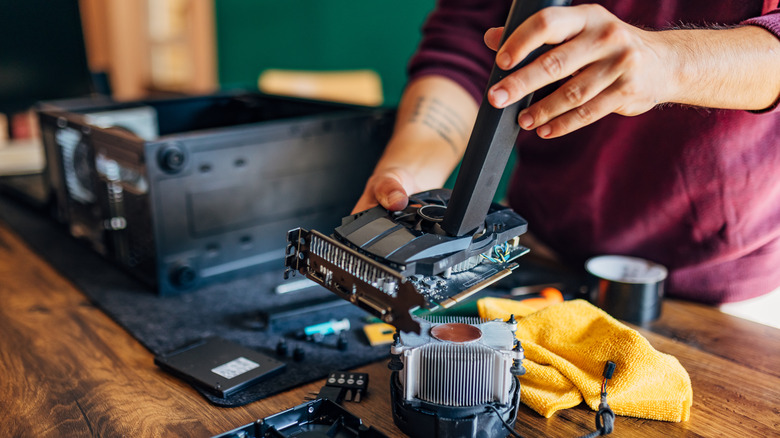
The equipment that powers adventure in the digital world is potent, complex, and constantly evolving. The video game may have started its journey as a simple traveling ball game in titles like “Tennis for Two” and “Pong,” but the experience has evolved incessantly in the years since. Modern gaming machines require high powered graphics processing units, or GPUs. Two of the most prominent GPU brands are Nvidia and AMD, but numerous other major graphics card brands also exist. Then there’s the used GPU market to consider, as well.
Modern gamers have the pick of the litter when it comes to finding the perfect GPU to augment their gaming experience. You might need a laptop GPU or one to slot into your custom tower PC, but the hunt remains largely consistent either way. Those looking for new gear to upgrade their system will frequently start with the key metrics available from the market’s current options, but it can sometimes be difficult to determine when this search needs to start. Obviously, if your PC starts failing at a heightened rate, a change in the hardware is likely required. But barring a major catastrophe in your setup, what kinds of signs should prompt the beginnings of a search for new gear? When it comes to your graphics card, these five indicators can be a solid guide that tells you a change may be required.
>>>L500EPS-01 Charger for Dell XPS 8950 Optiplex 7000
Your PC can’t maintain consistently high frame rates
Whether you’re a competitive gamer or a casual player who relishes in the experience of high-end equipment, there’s no getting around the demand for games running at a smooth, consistent frame rate. Simpler games don’t typically have much trouble in keeping FPS figures at 60 or higher, perhaps even extending into the triple digits. But the most GPU-intensive titles can bog down your system and cause this part of the experience to lag behind. A monitor with a high refresh rate delivers a seamless gaming experience when it’s well cared for, but a lackluster frame rate can tank your gameplay and introduce plenty of frustration into the picture. In highly contentious multiplayer efforts, it can be the difference maker between buttery smooth operations that allow you to gain the upper hand and a clunky gameplay mechanic that slows you down and leaves you vulnerable.
Many high quality graphics cards don’t have much trouble in handling the intense workloads required to produce 60 FPS gameplay or better at a consistent rate. But the longer you use the same card the slower it will become in working through these processes. Similarly, the longer you use the card the older it gets and the farther behind it ultimately becomes when compared to the newest technology and game demands. If you’re seeing a slow down in your gameplay, looking for a new GPU may be a requirement to keep current.
>>>505979-3S1P-1 Battery for Chuwi CoreBook X Pro 14 13.3
Monitoring GPU usage against CPU utilization identifies performance hangups
One of the first ports of call you should attend to if you see your computer slowing down while you adventure through an RPG or mow down enemies in a shoot ’em up universe is your system monitoring tools. Monitoring the workload of your hardware as you boot up a game and play it will help you get a clearer sense of what is going on with your system.
In many cases, either your CPU or GPU units will be running at or near full capacity, but this doesn’t mean a 90% usage rate is necessarily a bad thing. Some heavy-duty games demand that your hardware works overtime to accommodate the stunning visuals and complex processing behind the scenes. With that being said, if you’re GPU is working overtime while the CPU exhibits far less intensive demands at the same time as your game struggles to load or your refresh rate dips, you can be fairly certain of the culprit. Under these circumstances, the problem is most likely a graphics card that’s no longer up to the task of handling the processing demands placed upon it. The trouble might be in booting up new title that requires extreme processing power, but the underlying issue remains and will only get worse as time continues to march forward.
Ray tracing isn’t available in your current setup

In 2018, ray tracing became next big thing in the gaming world. This computational process focuses on rendering light sources in the image in a more natural manner. Lamps, sunlight, and even screens that you might encounter while in the world of your chosen video game emit light that needs to be dealt with in the creation of an on-screen image. Rendering these light sources has frequently been a point of contention in the past, but ray tracing has revolutionized that process and made in game lighting far more realistic. The result has been nothing short of transformative for the process of immersing yourself in the simulated world of the video game.
This complex process is fairly new, and naturally requires a huge amount of processing power to accomplish. Not all graphics cards can accommodate ray tracing, especially those with a few years under their belts. Contemporary cards feature dedicated cores that only handle ray tracing elements. Others have enough processing power to accomplish the task but may require computational sacrifices elsewhere in order to enable this function. Ray tracing is only going to become increasingly more prominent in games released today and into the future. If your graphics card can’t accommodate this process, it may be time to make a switch in order to upgrade your setup.
Your current GPU is over three years old
Each new wave of technological advancement both in game design and graphics card capability leaves existing hardware increasingly further behind. With each passing year, not only is your graphics card piling up the workload it has accomplished and degrading its physical components in the process, but it’s also one year further removed from the cutting edge. Most major GPU brands release a new iteration of their products every two years, on average. For most gamers there won’t be any need to replace your hardware with each new release, but after a second new offering hits the market between what is current and your existing setup, you may want to start looking into replacement opportunities.
Conventional wisdom suggests your GPU will remain viable for up to five years. It should continue performing without failure for as many as eight to 10, but most gamers won’t want to endure the performance sacrifices that come from being this out of date. With two new releases, your GPU will be four years old if you bought a brand new unit when it first came out. Four years is a long time in the technological life cycle game design and computational power. Over this time, your graphics card will likely see an increasing workload to keep up with modern demands as they evolve, and it may even fall out of the spectrum of recommended solutions to handle the computational requirements of modern games.
Your graphics card is frequently overheating
One final signal that you’re looking at an aging graphics card is a physical one. If your hardware is starting to overheat as you use it, you may be looking at a GPU that is no longer viable for the usage load you expect from it. Problems in the physical infrastructure of the component may be to blame, or you may be working with a card that is rapidly falling out of contention as a viable solution to handle the demands of the titles you frequently play.
It’s worth noting that you may also be looking at an issue with the cooling system rather than the processing power of the card itself. If your computer isn’t venting properly or the fans within the tower aren’t delivering enough cooling power because of some other issue that may be going on, addressing these concerns might resolve the (different) underlying problem. However, if you’ve explored alternative explanations for the heat issue within your system and have come up empty, it’s likely that your graphics card is due for a replacement.